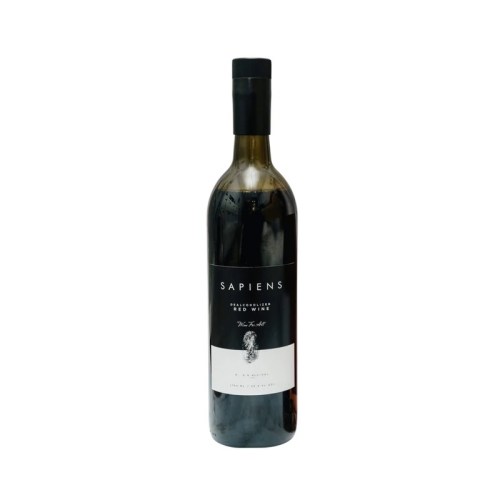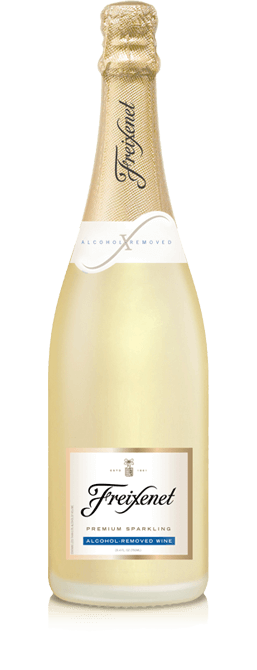Our editors independently select these products. Making a purchase through our links may earn Well+Good a commission
Why Alcohol-Free Wine Deserves Your Attention (And the Best Brands To Buy)
Learn exactly how alcohol-free wine is made and how it's different from grape juice. Plus, shop great-tasting ones to try.

Growing up, the few times a year when my family had a “fancy” dinner, my parents would plop a bottle of Welch’s sparkling grape juice on the table. While the adults sipped champagne, my brother and I would toast with our own sparkling bubbly feeling like royalty.
Experts in This Article
Jonathan Nagy is a winemaker at Hand on Heart (part of Miller Family Wines), which produces both traditional wine and alcohol-removed wine.
Julia Littauer is the co-founder of alcohol-removed wine brand Sovi.
Tolu Obikunle is the CEO and founder of Sapiens, an alcohol-removed wine brand.
Tommy Gaeta is the director of marketing at Hand on Heart Wine, which produces both traditional wine and alcohol-removed wine. Hand on Heart is part of Miller Family Wines.
Yoko Sato is the head winemaker for alcohol-removed of Freixenet. She lives in Spain.
As an adult, I still think Welch’s sparkling grape juice is great and it’s fun to see my tween nephews enjoying it just as much as I did as a kid. But at this point in my life, I’ve also had my fair share of actual champagne and wine, and now I know that there’s a pretty major difference between the taste of these alcoholic beverages and the faux sparkling stuff I used to revere.
It’s one reason why I didn’t even think to buy a bottle of sparkling grape juice when I started reevaluating my pandemic drinking habits a few months ago. (This is a no-judgment zone, right?) Yes, there are a lot of amazing non-alcoholic spirits out there (so well-crafted in-fact, that Well+Good named it as one of our 2022 Wellness Trends), but when I’m just chilling alone at home, I’m a wine girl through and through. It also didn’t seem like a great idea to sub out wine for something with 28 grams of sugar per serving. (Comparatively, a glass or wine has roughly one gram per serving.)
Then I discovered alcohol-removed wine, also called de-alcoholized wine. As the name suggests, this is legit wine with the alcohol removed. When it’s well-made, it tastes just like traditional wine. (Just like with real wine, there are great-tasting brands and not-so great tasting ones out there.) Excited with my discovery, I showed up to Thanksgiving proudly presenting a couple of bottles of Freixenet alcohol-removed sparkling wine. My grand gesture was anti-climatic. “Oh thanks for bringing that, but we already have the Welch’s,” my dad said. “But this is different! It tastes like wine!” I shot back. Once my parents actually popped open a bottle and tried it, they agreed. But the difference isn’t just in the taste; they are made entirely different, too.
Now I realize we’re literally talking about champagne problems, but to actually understand the difference between grape juice and alcohol-removed wine, it’s important to know what goes into making these products. So, I got five experts in the space to explain it.
First, what they have in common: grapes
Before we get into how the heck alcohol is removed from wine, let’s start with a little 101 lesson on how grape juice and wine are both made. As you might expect, both involve grapes. With juice, grapes are crushed and blended into a liquid. A lot of time on juice labels, you’ll see “grape juice from concentrate” on the ingredients list. This means excess water from the grapes was removed, making the juice more concentrated. Brands can choose to incorporate other ingredients for taste, color, and texture. For example, Newman’s Own Grape Juice adds cane sugar, citric acid, and natural flavors. Juicy Juice grape juice has a similar ingredients list, also incorporating apple juice concentrate.
The big difference between how grape juice is made and how wine is made is that wine is fermented and includes yeast. The exact fermentation process varies depending on the type of wine, but all wine is fermented. During fermentation, the yeast converts most of the sugar to alcohol and carbon dioxide. Wine brands can also choose to add other ingredients for taste, color, and texture, but unlike juice, they are not required to disclose what they add to the label.
“The Food and Drug Administration and U.S. Department of Agriculture have a very specific definition of juice, which specifies that it cannot undergo a fermentation process,” says Tolu Obikunle, the CEO and founder of alcohol-removed wine brand, Sapiens. “This is exactly why de-alcoholized wine is not grape juice. You ferment it just like regular wine and then remove the alcohol.”
Yoko Sato, the head winemaker for alcohol-removed at Freixenet, which makes both traditional and alcohol-removed wine, says keeping the fermentation as part of the process for making alcohol-removed wine is key. “Wine gets so much of its aromatic properties during fermentation,” she says. This highlights one major difference between grape juice and alcohol-removed wine: The alcohol-removed wine is fermented and grape juice is not. In turn, this greatly affects how the end result tastes.
Okay, so grape juice, wine, and alcohol-removed wine all start with grapes. Grape juice isn’t fermented but the other two are. But that isn’t the only difference. “One difference between grape juice and our alcohol-removed wines is the sugar content,” says Jonathan Nagy, a winemaker for Hand on Heart, a wine collection part of Miller Family Wines. The brand just launched its first alcohol-removed line this year, which includes a rose, chardonnay, and cabernet sauvignon, all $15 each. “In grape juice, the backbone of sweetness is often sugar. For us, it’s the grapes,” Nagy says. “Even many full-fledged wines with alcohol have a lot of sugar added in, but we don’t do that. As a result, our sugar levels are significantly lower than grape juice and also lower than most of the alcoholic wine out there.”
This highlights another big difference between grape juice and alcohol-removed wine: the sugar content. Sato (of Freixenet) says keeping sugar low was also front of mind for the brand when creating their alcohol-removed sparkling white and sparkling rose. “[Most] people who are seeking out alcohol-removed wine are looking for something dryer and low in sugar,” she says. Julia Littauer, the co-founder of alcohol-removed wine brand Sovi, says this was important to her, too. It’s not just empty words; since all non-alcoholic beverages must list their ingredients and nutritional info, you can see it plainly on the label. The total sugar in Sovi’s red blend? One gram.
But getting the desired end result—a drink that still tastes like wine and isn’t full of sugar—isn’t easy. De-alcoholizing wine is tricky and as all the people interviewed for this article express, takes lots of trial and error.
How alcohol-free wine is made
The most common method for removing alcohol from wine is using a vacuum distillation process. Scratching your head? Littauer explains it this way: “First, you create wine just as you would if you weren’t going to remove the alcohol,” she says. Then, the vacuum distillation removes the alcohol by boiling it at a low temperature.” Littauer explains that it’s very important that the temperature sticks to 85°F. If it’s any higher, it boils away some of the properties of the wine you’re trying to keep, namely the flavor notes and body. “After the alcohol is boiled away at a low temperature, what you’re left with in the vacuum is non-alcoholic wine that still has the aromas and flavors of the original wine,” Littauer says.
Littauer says that, just like with wine, the grape quality comes through after the slow-boiling process. “What I think sets us apart from other brands is that we source our wines from a family-owned vineyard in California. We work with them to grow and pick the type of grapes that work exactly with this style of wine in the end so we don’t have to do much after the distillation process,” she says.
Freixenet, Hand on Heart, and Sapiens all use this vacuum method too, according to the brands’ founders and winemakers. Hand on Heart specifies that the machine they use is produced by BevZero. This hunk of metal is seriously impressive. It’s able to separate out the molecules responsible for the wine’s aroma and flavor. Then, they’re condensed and stored in a holding vessel. Meanwhile, the rest of the liquid goes through another chamber, where the low-boiling process occurs. This removes the alcohol. Eventually, the molecules that were separated out are added back in. “It’s a very gentle process,” Nagy says.
Still, Nagy says that removing the alcohol does take away from some of the wine’s original flavor and body. “With all three of our alcohol-removed wines—chardonnay, rose, and cabernet—we add back nuances of flavoring that would be there had the wine not gone through the process,” he says. This was the real tricky part and he says involved a lot of taste-testing. Tommy Gaeta, Hand on Heart’s marketing director agrees. “There are all these cues in wine that we are trying to preserve, like the buttery notes in chardonnay or the tannins in the cabernet,” he says. “We want the alcohol-removed wines to have these same qualities just like the [traditional] wines.” Nagy says getting all three perfect took several months.
Sato, the winemaker at Freixenet, echoes Nagy that removing the alcohol does affect the taste of the drink, something that requires a lot of attention after the vacuum distillation. “If you start with a wine that’s 10 percent alcohol, which is standard for a white, eliminating 10 percent of the liquid is going to create an imbalance,” she says. “So you do have to reconstruct it a bit.” For them, this is done using natural aromas and sugar, though the end result still has less sugar than grape juice.
Here’s what else Sato says is tricky: Alcohol-removed wine is more sensitive to environmental change than traditional wine, so it can’t just sit around and age at a winery; it has to be shipped to retailers sooner. She also says it’s filtered more than the wine to ensure there are no product-spoiling micro-organisms in it. “[For us], it’s actually more expensive to create the alcohol-removed wine than the traditional wine,” she says.
Can you see now how these drinks are definitely different from a glass of Juicy Juice? Not that there is anything wrong with juice—especially when it’s made fresh. But if you’re looking for something that’s as close to real wine as you can get while keeping the proof at zero (and keeping you from googling “how does alcohol affect sleep” when you wake up groggy after what seemed like a moderate amount to drink), alcohol-removed wine is absolutely your best bet. Just like graduating from the kids’ table at Thanksgiving, it’s time to upgrade what’s in your glass too.
Shop alcohol-free wine options

Sapiens Dealcoholized Wine — $38.00
Aged in oak, this red alcohol-removed wine is made from Spanish tempranillo grapes.

Chateau Diana Alcohol Removed California Red Wine and Cabernet Sauvignon — $30.00
This duo has an Amazon rating of 4.6 out of 5—not too shabby considering how tricky it is to perfect a red.

Sovi Sparkling Rose (4-pack) — $28.00
Co-founder Julie Littauer says the brand chose to use cans instead of bottles because most people don’t drink a whole bottle at once; they just want one serving. “People are also more likely to recycle cans,” she says. Plus, how cute are they?

Ariel Alcohol-Removed Cabernet Sauvignon (2-pack) — $31.00
This cabernet sauvignon was aged in an oak barrel and has notes of black currants, cherry, blueberries, and chocolate. Delish, right?
ThirdLove Just Launched Bras That Help Balance Your Body Temperature—Here’s Why That’s a Game-Changer for Women in All Life Stages

These Are the Only Types of Underwear You Should Be Wearing, According to Gynecologists

These Are the Summer Essentials You Should Bring With You Every Time You Leave the House, According to a Derm and an RD


Hand On Heart Alcohol-Removed Chardonnay — $15.00
Chardonnays are known for their full body and buttery flavor profile. This one definitely delivers and also has hints of mango, peach, and apricot.

Freixenet Alcohol-Removed Sparkling White Wine — $11.00
Celebrating something? Pop a bottle of this sparkling white, produced in Spain.
Oh hi! You look like someone who loves free workouts, discounts for cutting-edge wellness brands, and exclusive Well+Good content. Sign up for Well+, our online community of wellness insiders, and unlock your rewards instantly.
Sign up for the Well+Good SHOP Newsletter
Get exclusive deals on wellness, beauty, fitness, and food products that have been hand-picked by our editors.
Got it, you've been added to our email list.







